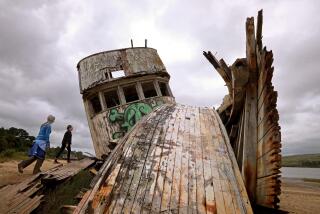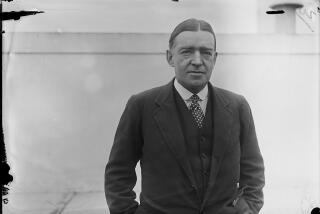A Time Capsule of Tudor History : Artifacts From 1545 Shipwreck on View at Museum
- Share via
July 15, 1545, was recorded as a warm, sunny and almost windless day off the coast of Portsmouth, England. King Henry VIII, surrounded by courtiers gathered at Southsea Castle, watched the progress of his fleet, making its way into the English Channel to repel a French invasion.
The British monarch gazed at the panorama of 60 of his warships about to do battle with a vastly superior armada sent by the French king, Francis I. One particular vessel a mile from shore caught his eye. It was the Mary Rose, which had been named for his sister when launched in 1511. Suddenly a wind from shore filled its sails. The ship listed to starboard as the sea rushed through her open gun ports, and the Mary Rose capsized.
Anti-boarding nets stretched across the deck trapped the crew and soldiers like a school of fish. Their screams could be heard ashore as the ship disappeared in less than a minute, settling in silt at a depth of 40 feet. Seven hundred men drowned, including its captain, Richard Grenville, and the vice admiral of the English fleet, George Carew. There were only 30 survivors, mostly longbowmen stationed in the fighting tops. The men who perished would lie entombed for more than four centuries, trapped in a time capsule of English Tudor history.
The frame of the Mary Rose was finally brought to the surface in the fall of 1982 after 17 years of one of the most ambitious underwater archeological projects ever attempted. During this time more than 17,000 objects and timbers were recovered.
They ranged from an 11-foot cast-bronze cannon to a tiny pair of dice a sailor had once rolled across one of the ship’s oak tables.
Artifacts from the Mary Rose are now on display at the Natural History Museum of Los Angeles County in Exposition Park in an exhibition made possible by the Armand Hammer Foundation and Occidental Petroleum Corp. in cooperation with the Mary Rose Trust in England.
Margaret Rule, archeological director of the Mary Rose Trust who came from London for the opening of the exhibit, has been involved with the recovery project since its beginning. An article she wrote for National Geographic magazine in 1983 about the quest for the ship brought worldwide interest in the Mary Rose and the efforts of volunteers who helped bring the wreckage and the ship’s contents to the surface. Between 1979 and 1982, up to 50 divers worked each day from dawn to dusk. Rule was one.
“I had never dived before in my career as an archeologist,” she related, “but I learned quickly. There had been prior attempts to recover the Mary Rose; the first after the ship sank, and guns were removed during the 1800s. However, what had prevented others before us was the nature of the Solent, the channel off Portsmouth. It consists of banks of sand, fine mud and silt that is constantly stirred by tidal actions.”
Storm Exposed Timbers
Rule credited the vision of Alexander McKee, a scuba diver and military historian for initiating the search for the ship. Finally, in 1971, storms exposed the ends of the vessel’s timbers in the silt, and Rule and McKee knew they had found the Mary Rose. The silt that hid the ship had formed a protective cocoon over most of the artifacts.
“We had to protect the wreck from looters,” Rule continued. “We formed a Mary Rose Committee and leased the site from the Crown for one pound a year. After we recruited a team of volunteer divers and technicians, we formed the nonprofit Mary Rose Trust to direct operations and raise funds. Prince Charles, who made nine dives on the wreck, agreed to become president of the trust, and I was appointed chief archeologist.”
Prince Charles would later write that what had been a part-time project for many of the volunteers became the greatest underwater archeological operation ever seen. He also later commented on the diving conditions in the Solent where those working underwater could barely see in front of their face plates: “It was like diving in cold lentil soup.”
Removed Piece by Piece
Rule described how the artifacts were removed piece by piece during the years of recovery before the remains of the hull were raised in 1982 and placed in a dry dock at the Portsmouth Naval base within a few yards of the spot where it was built 471 years earlier. The vessel now occupies Ship Hall at the Mary Rose Museum on the naval base.
The Mary Rose was a vessel of 700 tons called a carrack, the only one of its kind ever discovered. Her masts were either recovered immediately after the sinking or drifted away as flotsam during the centuries that followed.
As the team of archeologists under Rule catalogued and cleaned the artifacts discovered, a picture of life aboard a fighting ship of the era began to emerge.
The Mary Rose’s main ordnance consisted of 71 guns in addition to a variety of smaller weapons that could be hand-held when fired. One type was called a hailshot piece, which fired sharp-edged cubes of iron that were known as dice shot. Examples of the weaponry are on display.
Despite the use of cannon (King Henry had subsidized the development of heavier and more lethal guns) most of the 251 soldiers aboard the ship were longbowmen. The English were regarded as the finest archers in the world. Tudor law required all the king’s able-bodied male subjects to practice with the longbow. When an English boy was strong enough to draw a bowstring, his father gave him his first weapon and a quiver of arrows.
12 Arrows a Minute
A well-aimed arrow was accurate within 300 yards, about the effective range of a modern M-1 carbine used in World War II and Korea by Marines and the Army. With a six-foot bow, an archer could shoot about 12 arrows a minute at a target. There were 2,500 arrows and 139 longbows recovered from the Mary Rose.
“Many were so well preserved that they could be restrung and used today,” Rule said.
The bones of about 200 men were found and raised for a proper burial. Rule recalled discovering one archer. “His skeleton lay beside a ladder connecting the gun deck to the weather deck, where he was trying to escape the inrushing water,” she said. “A bundle of arrows in a leather quiver was attached to his spine by a thong. Two of his middle vertebrae had been pulled forward and twisted to one side as evidence of chronic pressure on his spine. Clearly, this man had been a veteran archer.”
Examples of Dinnerware
Examining the examples of fine pewter dinnerware on display, including flagons once filled with wine, one can almost visualize the ships’ officers gathered at a wardroom table for an evening meal.
Although the crew ate from plain wood plates and downed their beer in wood mugs, they were obviously well fed. Bones discovered show they ate fish, venison, mutton, beef and pork with plenty of fresh fruit and vegetables. Peas still in their pods were discovered in the wreckage as well as wild cherry pits and hazelnut shells.
Scurvy that was to decimate crews of ships bound for the New World and other lengthy voyages of exploration into the Pacific apparently was not a problem for the men aboard the Mary Rose.
More objects were brought to the surface: pocket sundials used for determining the time, leather shoes worn by the crew--the officers preferred fancy slippers--a chest containing a magnetic steering compass suspended on gimbals, dozens of pocket combs, sewing kits containing ribbon, braid, buttons and thimbles, leather jerkins, wood carvings whittled by crew members to pass the time, and chests filled with carpenters’ tools.
A single backgammon board inlaid with spruce and yew complete with counters had probably belonged to an officer. It was a popular game in England during that period, often played for high stakes.
The Mary Rose apparently had a small orchestra aboard. Among the musical instruments found were a number of three-holed tabor pipes, a drum and the remains of several fiddles. One diver picked up an elaborate reed instrument thought to be a shawn, ancestor of the oboe.
Medical Chest Found
One of the great finds of the 1980 diving season was the medical chest from the ship. The surgeon was skilled in everything from giving the captain a shave and a haircut to amputating a wounded sailor’s leg.
Aboard the Mary Rose, the surgeon and his mates would have been busy during a battle treating ghastly wounds. Iron shot could cut a man to shreds, a round stone ball from an enemy cannon might sever a limb, or a bolt from a French crossbow was apt to skewer the hapless recipient of the arrow.
In the chest were a number of wood containers with ointments that were so well preserved they still held the physician’s fingerprints. Laboratory analysis of these ointments show the presence of what may be frankincense and rosin in a wax base used to treat ulcers and fistulas.
The chest also contained brass and pewter syringes, a bleeding bowl (to collect blood when a patient was bled) and a heavy bronze mortar for grinding drugs. The surgeon’s steel surgical tools have not survived, but wood handles of the instruments did.
The loss of the Mary Rose had little effect on the battle with the French fleet. It ended in a stalemate as the French attempted an invasion of the Isle of Wight that was repulsed by the inhabitants. The French left the Solent on July 21, attacking towns on the Sussex coast. The French fleet sailed home across the Channel. After a month at sea it was short of rations, and worse--plague had broken out on the ships.
The Mary Rose exhibit will continue until Oct. 15. The Natural History Museum is offering a series of lectures on Tudor England held on Sundays at 2 p.m. There is also a film series on Tudor women shown on Saturdays from Aug. 16 to Sept . 20. The museum is at 900 Exposition Blvd. It is open Tuesday through Sunday (closed Monday) from 10 a.m. to 5 p.m. Admission is $1.50 for adults and 75 cents for children.
More to Read
Sign up for The Wild
We’ll help you find the best places to hike, bike and run, as well as the perfect silent spots for meditation and yoga.
You may occasionally receive promotional content from the Los Angeles Times.






